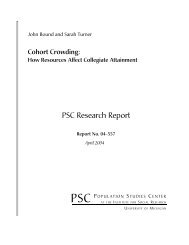Population Ageing and the Well-Being of Older Persons in Thailand ...
Population Ageing and the Well-Being of Older Persons in Thailand ...
Population Ageing and the Well-Being of Older Persons in Thailand ...
Create successful ePaper yourself
Turn your PDF publications into a flip-book with our unique Google optimized e-Paper software.
Section 4: Health Status<br />
The percentages who have difficulty do<strong>in</strong>g <strong>the</strong>se<br />
activities <strong>in</strong>dependently varies considerably by age.<br />
Substantially higher percentages <strong>of</strong> persons age 70 <strong>and</strong><br />
over compared to those <strong>in</strong> <strong>the</strong>ir 60s, have difficulty<br />
do<strong>in</strong>g <strong>the</strong>se activities without help from o<strong>the</strong>rs or, for<br />
some <strong>of</strong> <strong>the</strong> activities, without <strong>the</strong> use <strong>of</strong> some type <strong>of</strong><br />
aid. Women are more likely than men to report<br />
difficulties <strong>in</strong> do<strong>in</strong>g each <strong>of</strong> <strong>the</strong>se activities on <strong>the</strong>ir<br />
own. Also, except for us<strong>in</strong>g transportation <strong>and</strong><br />
count<strong>in</strong>g change, urban older persons are modestly<br />
more likely to report functional problems than rural<br />
elderly.<br />
Presumably, an <strong>in</strong>ability to <strong>in</strong>dependently eat, dress,<br />
ba<strong>the</strong> or use <strong>the</strong> toilet by oneself signifies <strong>the</strong> most<br />
severe functional limitations <strong>and</strong> <strong>the</strong> greatest need for<br />
a caregiver to assist on a daily basis. Panel A <strong>of</strong> Figure<br />
4.4 shows <strong>the</strong> percent <strong>of</strong> elderly who <strong>in</strong>dicate<br />
difficulty <strong>in</strong> do<strong>in</strong>g at least one <strong>of</strong> <strong>the</strong>se three activities<br />
on <strong>the</strong>ir own <strong>and</strong> divides <strong>the</strong>m <strong>in</strong>to those who report<br />
<strong>the</strong>y receive assistance from someone <strong>in</strong> carry<strong>in</strong>g out<br />
daily liv<strong>in</strong>g activities <strong>and</strong> those who <strong>in</strong>dicate no one<br />
assists. Overall less than four per cent <strong>of</strong> older persons<br />
report limitations with respect to any <strong>of</strong> <strong>the</strong>se most<br />
basic activities. However <strong>the</strong> percentage <strong>in</strong>creases with<br />
age <strong>and</strong> is by far <strong>the</strong> highest for those aged 80 <strong>and</strong><br />
over. Women are more likely than men <strong>and</strong> elderly<br />
urban residents are more likely than <strong>the</strong>ir rural<br />
counterparts to report at least one <strong>of</strong> <strong>the</strong>se basic<br />
limitations. One consistent f<strong>in</strong>d<strong>in</strong>g, however, across<br />
age, gender <strong>and</strong> area <strong>of</strong> residence is that a large<br />
majority <strong>of</strong> those who have one <strong>of</strong> <strong>the</strong>se basic<br />
functional limitations also have someone who assists<br />
<strong>the</strong>m.<br />
Panel B <strong>of</strong> Figure 4.4 exp<strong>and</strong>s <strong>the</strong> def<strong>in</strong>ition <strong>of</strong><br />
hav<strong>in</strong>g a functional limitation to <strong>in</strong>clude not only one<br />
<strong>of</strong> <strong>the</strong> basic limitations considered <strong>in</strong> panel A but also<br />
anyone with a major mobility problem def<strong>in</strong>ed as both<br />
nei<strong>the</strong>r be<strong>in</strong>g able to walk to 300 meter nor to climb<br />
2 or 3 steps <strong>of</strong> stairs. Broaden<strong>in</strong>g <strong>the</strong> def<strong>in</strong>ition more<br />
than triples <strong>the</strong> share <strong>of</strong> older persons hav<strong>in</strong>g a<br />
functional limitation to 12 per cent. The differences<br />
related to age, gender <strong>and</strong> area <strong>of</strong> residence rema<strong>in</strong>s<br />
36















